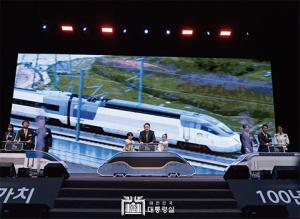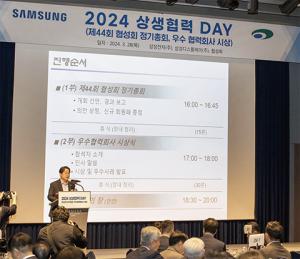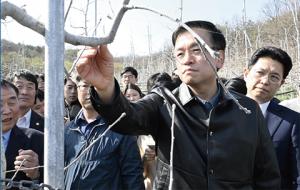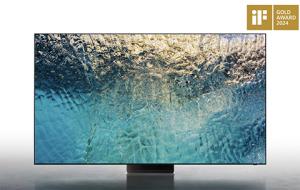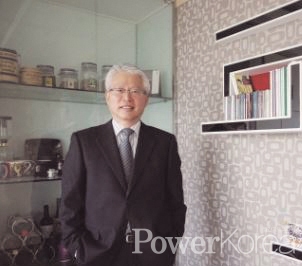 |
||
| ▲ FC Korea Land CEO Saekyung Sung | ||
(PowerKorea) ‘Urban heat islands’ occur when cities replace natural land cover with dense concentrations of pavement, buildings, and other surfaces that absorb and retain heat. This effect increases energy costs, air pollution levels, and heat-related illness and mortality. While Canada and California US recorded 50 degree Celsius, the capital region of South Korea is experiencing around 36 every day with high humidity that make people sweat like raining. Tarmac covering the traffic lanes and high rice concrete buildings in the city play a great role to form urban heat islands as they contain the heat day and night without emitting. The rubber materials on the running tracks and children’s playground also play a part.
Cork as alternative to concrete and rubber
South Korean eco-friendly materials company FC Korea Land is using cork as an alternative to concrete and rubber used for covering roads and the ground. The company developed this cork material by using oak tree bark mixed evenly with eco-friendly binder into a matt-type to be attached to the ground. Cork is widely known as the lid of wine bottles and Portugal is the biggest cork producer in the world. In South Korea, slash burn farmers in mountain areas gained cork from platycarya tree to build houses in the past. English scientist Robert Hooke (1635-1703) is the one who found cell walls in cork tissue and coined the term ‘cells’ for the first time in history. A 1cm³ cork has more than 42 million cells which is covered by the substance called suberin which is not found in normal timbers. Cork has excellent water permeability thanks to suberin and the cork covered roads easily absorb the rain down to the underground and have strong durability that the roads last more than 10 years.
Cork as eco-friendly material
In South Korea, urethane is used for running tracks and children’s playgrounds. Tests on chemical substances in urethane have been carried on for the last several years and it was turned out that the harmful substances such as lead, chrome and phthalate exceeded the standard. A test on cork carried out by the Korea Testing & Research Institute, on the other hand, found zero harmful substance on 7 harmful substances such as T-VOCs, benzene, toluene, ethylbenzene and xylene; in addition, cork showed more than the KS standard on tensile strength, elongation rate, permeability coefficient, skid resistance and shockproof.
Cork as urban heat islands-resistant
On a test of exposing to the sun for 2 hours and 45 minutes in late June, the surface temperature rose to 35.2 degree Celsius in rubber material, 39.3 in concrete material but the cork kept 31.6. On a test by time slot between rubber and cork, the result was as follows: at 08:30am 26.2 rubber : 25.7 cork, at 12:30pm 65.5 : 54.6, and at 17:30pm 32.1 : 30.1. Experts say that cork can be used as an urban heat islands-resistant material based on these test results.
Cork as a core material of Korean New Deal
United Nations Climate Change Conference (COP17) agreed to include harvested wood products as carbon-containment materials and the Kyoto Protocol also encourages producing wood products as an activity of reducing carbon. A unit volume of cork contains 142kg/m³ carbon. It is estimated that cork used for a 22m² trail and a 10m² children’s playground can contain about 1 ton of carbon. These results prove that cork can be a core material of the Korean New Deal. In accordance, South Korean government introduced KS F 8980 (Korea Standard) for water permeable cork to be used as an eco-friendly ground covering material February last year, and issued an innovative product certificate to FC Korea Land February this year.
Cork road walking campaign
We can gain cork from oak trees every 10 year. While quantity of cork is being imported from Portugal, the Korea Forestry Promotion Institute and FC Korea Land joined hands to localize the supply on a 1.2 billion won ($1 million) R&D fund. Alongside, Saekyung Sung, CEO of FC Korea Land, is pushing forward a cork road walking campaign in a way to promote excellence of cork to the people. Cork of FC Korea Land has been installed in many schools, children’s playgrounds, swimming pools, parks and paths. Without digging up the existing concrete or soil ground, cork is applied on the surface. Apart from roads and the ground, cork can be applied to many areas and products such as soundproof walls, hats and bags.
CEO Sung says that FC Korea Land will keep carrying on its R&D to introduce a variety of by-products by using the most of its cork material techniques.
 |
PowerKorea is an official partner of Herald Corporation. The magazine is distributed to the KOTRA business centers in the world. PowerKorea publishes latest news of government, Samsung, Hyundai and LG and endeavors to serve a platform to engage with people around the world.
신태섭 기자 tss79@naver.com

